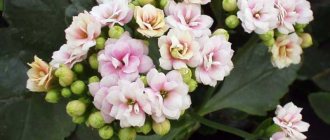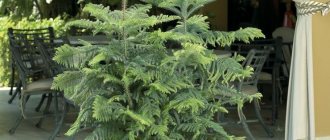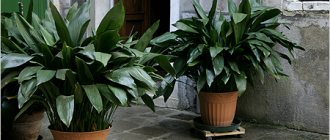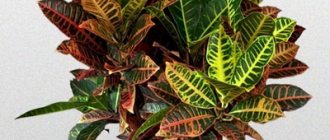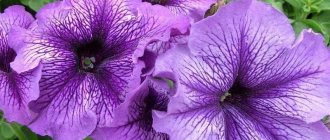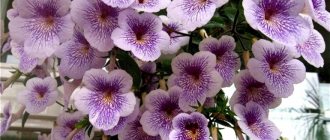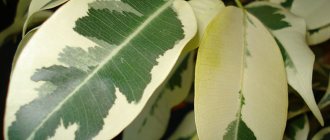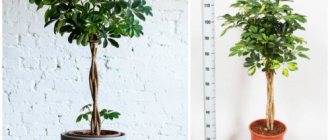The homeland of fatshedera is France, it was there, in 1912, that breeders developed this type of plant, which begins its development in the form of a bush, but as it grows it turns into a vine with loose umbrella inflorescences.
Fatshedera Lize is a perennial with a high intensity of development, stretching by 40 - 90 cm per year, with a maximum total length of no more than 6 m. It is widely used for decorative purposes not only indoors, but also when landscaping personal plots in the summer.
Also see how to grow homemade dizygoteca and schefflera.
| High growth rate, extending 40–90 cm per year. |
| Blooms in late summer with small flowers. |
| The plant is easy to grow. |
| Perennial. |
Features of fatheaders
Fatshedera is essentially a rare exotic plant. Quite a short time after this vine was created, it became very popular among both florists and gardeners. It is often used to decorate flower arrangements, and is also quite often grown on terraces, balconies and winter gardens. And such a flower looks great in a spacious hall or foyer.
Fatshedera is distinguished from other plants by its large dark green glossy leaf blades, which are similar to the foliage of ivy and fatsia. Throughout the entire period of foliage growth, its color does not change. The length of the leaf plate is about 30 centimeters, and its width is approximately 20 centimeters. Their shape can be finger-lobed or trifoliate. Very often, in fatshedera subspecies, along the edge of the leaf blade there is an irregular border of white or cream color, thanks to which the plant becomes even more spectacular and elegant.
The length of the bush can reach about 5 meters. At first it looks like a tree with a semi-lignified, weakly branched stem. If there is a desire, then the vine can be constantly grown in the form of a tree, but for this you will need to install a support (bamboo or wooden stick). If you pinch the shoots of the tree, then you can form a shrub that will delight you with its gorgeous green foliage for a long time. If there is no support, then the shoot will begin to creep, and over time it will become more like a vine. As it grows, the stem becomes woody, and dark brown bark appears on its surface. Over the course of a year, such a plant increases in length by 0.3–0.4 m.
In adult Fatshedera, in the last summer or first autumn weeks, the formation of umbrella-shaped flowers is observed, which can be colored cream or yellowish-green. Such flowers are part of paniculate inflorescences. At the end of flowering, dark blue berries are formed on the bush. This plant is highly hardy and can be grown in open ground, but only those regions where winters are mild and not too cold are suitable for this. When choosing a place for a vine, keep in mind that it needs a lot of bright light.
How to replant
Young plants grow actively, develop a root system, the pot quickly becomes small, so they are replanted every year or once every two years. An adult bush is transplanted once every 3-4 years. According to reviews from flower growers, Fatshedera tolerates the procedure easily, therefore, if there is a need to change the container, it can be replanted more often. Choose a stable pot, commensurate with the height of the bush, with a diameter 2-3 cm larger than the previous one. When calculating the volume, you need to take into account that a third of the pot will be occupied by drainage.
The time for transplantation is chosen before the start of active growing season - late March or early April. There is no need to free the roots from the ground - it is better to replant in a coma of earth, watering the bush 1-2 days before. The soil used to fill the voids in the new pot is similar to that used during planting. The following techniques help to remove a bush from an old container: knock on the walls, hold the blunt side of a knife between the ground and the wall, slightly tilt the pot.
If diseased roots or signs of infection are noticeable in the soil, then you will have to free the entire root system from the soil and inspect it more carefully, cut off the damaged areas, treat the sections with charcoal powder, and replace the soil if necessary. After filling the pot with soil, there should be 3-5 cm left to the edge of the wall.
Selecting a location
In order for the Fatshedera to grow and develop normally at home, it needs to create optimal conditions.
Illumination
This evergreen vine does best in a location with plenty of bright light. However, it can also be grown in shade. The optimal level of lighting in indoor conditions is slight shading. In the spring-summer period, if possible, fatshedera is recommended to be grown in open ground; for this, it can be planted in the garden or transferred in a pot to the balcony. A shady courtyard is perfect for such a plant. However, the choice of location must be taken very seriously, as it must be protected from direct sunlight. The fact is that the scorching sun can burn the leaf blades of the plant.
Humidity and temperature conditions
Fatshedera has a fairly high resistance to temperatures observed from spring to autumn. However, if the room is hotter than 25 degrees, the plant will become lethargic and temporarily lose its decorative effect.
In winter, it is recommended to keep the vine in a cool place (from 10 to 15 degrees). The air humidity level is maintained at a moderately high level. If the room becomes too hot (18 degrees and above), then the foliage on the bush must be moistened with a spray bottle, creating something like a warm shower. By the way, it is recommended to carry out a similar procedure from time to time throughout the year in order to remove accumulated dirt and dust on the leaf plates. This procedure also has an antibacterial effect. It is advisable to moisten the plant in this way once a week. In addition, remove dust from the foliage weekly using wet wipes. Protect the vine from cold air currents and drafts, as they can greatly harm it.
Growing fatshedera from seeds
For successful results, sowing is carried out in early spring or summer. On the surface of the calcined and moistened soil, the seeds are laid out at some distance from each other. Having sprayed the crops again with a spray bottle, they are covered with film and placed in a well-lit place with a temperature of at least 25 ºС.
Regular moistening and ventilation of crops will ensure rapid flower emergence. As soon as 2-3 leaves are finally formed, the sprouts are planted in separate containers.
Fatshedera care at home
You need to care for indoor fatshedera in almost the same way as other flowers growing at home. It must be watered, pruned, fed and replanted in a timely manner.
How to water
In the spring-autumn period, such an evergreen vine needs abundant watering, which should be done quite often. However, make sure that there is no stagnation of liquid in its root system, otherwise this may cause the development of root diseases. Some time after watering, be sure to drain the excess liquid that has accumulated there from the pan. In winter, the plant is watered much less frequently and less abundantly.
Depending on the air temperature in the room, the plant is watered with the following frequency:
- at a temperature of 24–26 degrees – once every two to three days;
- at a temperature of 20–24 degrees - the substrate in the pot is moistened once every 5 or 6 days;
- if the temperature in the room is kept at 16–18 degrees, then watering is carried out once every 7–10 days;
- if the room is quite cool (12–15 degrees), then you need to moisten the soil mixture in the pot no more than once every 30 days.
But remember that you cannot allow the earthen clod to dry out completely, no matter what the air temperature in the room is. Do not forget to loosen the surface of the soil mixture in the pot once every 15–20 days.
You can understand that there is stagnation of fluid in the root system by the foliage, which turns yellowish. If the vine needs urgent watering, then this can be guessed by the leaf plates that have lost turgor, which will fall down, and the shape of the crown will also change.
It is recommended to water the Fatshedera with well-settled or rainwater, the temperature of which should be close to room temperature. It is not recommended to water such a vine in the usual way; drip irrigation is best suited for this, which, if desired, can be combined with moistening the bush with a spray bottle.
When planting fatsheders, do not forget to make a good drainage layer at the bottom of the pot. It should occupy a third of the total volume of the container. And on top it is covered with an earth mixture consisting of 2 parts turf soil, 1 part sand and 1 part humus. To create drainage, it is recommended to use small pieces of brick or small expanded clay.
Fertilizer
It is necessary to systematically feed this evergreen vine only during the period of its intensive growth, which is observed from the first days of April to the second half of September. For fertilizing, both organic and mineral complexes are used, and these fertilizers are recommended to be used alternately. Fertilizers are added to the soil mixture regularly: 2–3 times a month. In winter, when the vine has a dormant period, there is no need to feed it.
You can find fertilizer for such a plant in a specialized store. To do this, you will need fertilizer for decorative foliage indoor plants, for example: “Vympel-2”, “Master Elite”, “Alliance”, “Agricola”, “Bona Forte”, etc.
Trimming
A similar vine, grown indoors, is very flexible and elastic. However, if it is not pruned in a timely manner, then it may develop one powerful central stem, while the side shoots will develop very poorly. This may cause the vine to lose its attractiveness. After the height of the bush is thirty centimeters, the first pruning is carried out, this is necessary in order to stimulate the growth of side shoots. Remember that in some cases, even with optimal growing conditions and good care, side shoots will practically not develop even after pruning, while the bush itself will be oppressed and weakened.
In order for your home to be decorated with a spectacular thick vine, it is recommended to plant 2 or 3 seedlings in one container at once, and do not forget to trim regularly.
Transfer
Until the young bush is five years old, it should be replanted once a year. Older plants are replanted less frequently, or rather, once every 2–3 years, and the top layer of soil mixture in the pot must be replaced every year. However, if you want your vine to always be thick and spectacular, then replant once a year, regardless of its age.
The pot for transplanting should be chosen not very wide, but high. Thanks to this, even a thick drainage layer will not interfere with the development of the root system. When replanting, do not forget that the old flower pot should be 20–30 mm smaller in diameter than the new one.
Experts advise replanting fatshedera in early spring (approximately in the first days of April), before the bush begins to actively grow. The substrate must be neutral or low acidity. It is recommended to replant the vine using the transshipment method, while trying not to destroy the earthen lump.
At the very beginning, you need to prepare a suitable container, and then the substrate. When there are two to three days left before replanting, you need to regularly moisten the soil mixture in the pot, but for this you need to use a small amount of water. Thanks to this preparation, the earthen lump will remain intact during transplantation. Next, remove the bush along with a lump of earth from the old container. To make it easier to remove the earthen lump from the container, place it on a hard and flat surface and lightly knock on its edges. Instead, you can take a long knife and run it along the inside of the container, trying to separate the soil mixture from the walls of the pot. After this, grasping the base of the vine, it is carefully pulled out. To harm the plant as little as possible, turn the container on its side.
After the bush is removed from the pot, inspect its root system for rot or signs of disease. If you notice signs of rot or any disease, then carefully remove all the substrate, being careful not to injure the roots. After this, use a sharp, sterilized instrument to cut out all damaged areas, and sprinkle the cut areas with charcoal powder. If the roots are healthy, then carefully remove the top layer of the old soil mixture, as well as the drainage layer along with the roots grown into it. Then place the bush in a new pot, and make a drainage layer at the bottom in advance. After the fatshedera is placed in a new container, all voids in it must be carefully filled with fresh soil mixture. Do not forget that the distance from the top layer of the substrate to the top edge of the container should be from 30 to 50 mm.
It is necessary to water the transplanted vine correctly. Since the substrate was regularly moistened for 2-3 days before transplantation, after it is transplanted, it does not need to be watered immediately. Wait 1 to 3 days, during which time the plant will dry out and heal any wounds on the roots that may have appeared during the replanting process.
Fatshedera lizei
An unpretentious evergreen vine with woody stems, up to 5 m high, with shiny palmate leaves in the shape of a hand with five fingers. The shoots initially grow upward, then become creeping. Round umbels of creamy white flowers are sometimes produced on mature plants in the fall. In good conditions it grows up to 1.8 m or more. Hardy enough to grow outside in areas with mild winters. Variegated varieties, such as "Variegata", are more light-loving, grow much slower and are more decorative, therefore more suitable for indoors.
Reproduction methods
Fatsheders use several methods for propagation, namely: seeds, cuttings and air layering.
Cuttings
This plant can be propagated by cuttings in the warm season. The best time for this is the last weeks of spring or the first weeks of summer. Prepare cuttings about 15 centimeters long; to do this, cut off the apical shoots. For rooting, they are planted in a soil mixture consisting of 1 part humus, 2 parts turf and 1 part sand. Cover the cuttings with a transparent bag on top, which will help create greenhouse conditions. After new buds form on the cuttings, the bag is removed.
Reproduction by air layering
It is relatively easy to propagate Fatshedera by air layering, which is why this method is most popular among gardeners. This procedure begins in the first days of April. Select one leafless side shoot and lightly cut it. Then moistened moss is placed in the area of the incision, and film is wrapped on top of it. If the sphagnum is damp all the time, then after about a couple of months roots will form at the cut site. When this happens, part of the shoot with horses must be cut out and planted in a pot with soil mixture. In order for air layering to quickly take root in a new place, it should be systematically watered. And in order for rooting to be successful, the top of the cutting is covered with a glass jar or a transparent bag; the cover can be removed after a week.
Growing from seeds
Fatshedera can also be grown from seeds, but they must be freshly harvested. To do this, the seeds formed on an adult vine are collected and used for sowing. Take a small container, fill it with soil mixture and place the seeds on its surface, which are not buried, but only lightly sprinkled with substrate on top. For seed germination, greenhouse conditions are needed; for this, the crops are covered with glass or film on top. After this, the crops are transferred to a dark place where the air temperature is constantly kept at 27 degrees. If everything is done correctly, the first seedlings should appear after 4 weeks.
Signs and superstitions
It is believed that Fatsia is protected by the planet Mercury, and the zodiac sign influencing the plant is Libra. This tandem gives Fatsia the ability to cleanse her home of bad energy and bad thoughts of others. If you or your household members often experience stressful situations or are depressed, Fatsia can help you cope with problems within your family by absorbing the negativity around you.
This lush green flower has a positive effect not only on the psychological, but also on the physical level, having a beneficial effect on the body in a number of chronic diseases (pathologies of the liver, kidneys, adrenal glands, bladder).
Possible difficulties
When cultivating Fatshedera indoors, the grower may encounter the following problems:
- The tops of the leaf blades turn yellow, and they themselves become brittle and dry, and spots also appear on them . This is due to the fact that the vine is not watered often enough or very sparingly. And the foliage may lose its decorative effect if the bush is in the heat (above 25 degrees). To correct the situation, you need to water the bush more often, and you will also need to increase the level of air humidity. If large brown spots appear on the surface of the foliage, and it itself begins to wrinkle, this means that the bush was exposed to direct rays of the sun, which caused burns. The way out of the situation is to shade the vines from direct sunlight.
- The foliage becomes faded and loses its shine . This happens when the fatsheder does not have enough light. In this case, the bush is moved to a place with brighter lighting.
- The liana quickly fades, and a gray fluff forms on its surface . This happens if the room is extremely cold and the humidity is very high. Move the bush to a place where both the temperature and humidity level would be optimal for this plant. Then trim off any wilted leaves and loosen the surface of the soil mixture in the pot. After this, the bush is treated with a solution of a fungicidal drug.
Remember that in an adult vine the leaf blades may fly off as they grow older and this is quite normal.
Fatshedera diseases and pests
The green pet is quite resistant to various diseases. The cause of many problems can be violations of the rules of care.
Its signs:
- Soil flooding - foliage turns yellow and curls (may gradually fall off);
- Dry air in the home - leaves have wrinkled or withered;
- The flower is very cold - a gray coating “with fluff” appears (cut off the damaged areas and lubricate the hybrid with a fungicide);
- A small amount of sunlight - small leaves become pale and lose their brightness and variegation, elongated shoots stretch;
- Sunburn - brownish round spots form on the leaves;
- Low soil moisture - the tips of the leaves dry out;
- Frequent and abundant watering leads to the formation of powdery mildew, the roots begin to rot.
Tree ivy can be “attacked” by the following pests:
- Aphids;
- Mealybugs;
- Shchitovka;
- Spider mite;
- Thrips.
In this case, succulent shoots should be immediately wiped or sprayed with a soap solution, and in case of severe infection, use the necessary insecticides.
Sometimes, due to a number of reasons, the vine becomes infected with its worst enemy - botrytis, which is a grayish rot. The lower stem part turns brown, rots, and a coating of fungal spores in the form of mold forms on it. If you do not sound the alarm, the botanical miracle will die within two weeks. An ivy tree infected with botrytis is left in a well-ventilated place with little humidity. But first, damaged stems and leaves are cut off from it.
Meaning for home
Since fatshedera was created using ivy, it adopted not only some genetic characteristics, but also some signs and superstitions. For example, it is believed that fatshedera has an extremely negative effect on men, causing aggression and negative energy in them. There is also an opinion that this vine can survive the man from the apartment, and it’s good that if he leaves, otherwise he may die. If there is such a plant in the apartment, the man will try to leave it as quickly as possible or will not even want to enter it. In addition, both ivy and fatshedera are considered “energy vampires”, absorbing happiness, self-confidence, optimism and peace of mind.
But the bad qualities of such a plant appear only when it is grown indoors. If you plant it in the garden, then on the contrary it will be a reliable protector of the residents of the house. Thanks to him, negative energy will not enter your home.
However, some superstitious people believe that, on the contrary, this vine is very useful, no matter where it is grown. It helps cleanse the biofield of the apartment, and also has a beneficial effect on the thoughts and character of the residents, and instills in them confidence and peace.
Description of the plant
First of all, you and I need to understand what the Fatshedera liana is, and only then begin to describe the contents of this flower. So, fatshedera is a rather young species, bred by French breeders as a mixture of ivy and Japanese fatsia.
It inherited its growth form from the first fatsheder, and from the Japanese flower it received a specific leaf shape and an interesting color. Fatshedera looks like a small tree, literally a meter in height, with five-pointed leaves and a thin trunk. In the wild, ivy can reach 5 meters, but decorative varieties are much smaller.
In another article we described the horned violet.
Its visual advantages allow it to be used as an element of a modern interior; a sophisticated flower will successfully complement and diversify the design of an apartment or workspace. The species grows quite slowly and is an evergreen, which also plays a role in the design of premises. Notably, fatshedera bears fruit that looks like a dark purple berry with a small seed inside.
Types of fatsheders with photos
Fatshedera has the following decorative varieties:
Variegata
The dark green leaf blades have a yellow or cream edging. This variety is characterized by fast growth, but poor resistance to pests and diseases.
Piya
The entire bush is covered with not very long bright green leaf plates, their edges are variegated and wavy, tightly adjacent to the shoot.
Silver Prince
This spectacular variety has a silver border on each leaf blade.
Type and varieties of fastheaders
There is only one species in the genus - Fatshedera Lize or Litze (lat. x Fatshedera lizei) - named after the breeder who created the new culture. The letter X in the Latin name of the species indicates its hybrid origin.
As for varieties, there are several more of them. Basically, variegated varieties were bred, differing in the pattern on the leaves:
- "Variegata" (Variegata) is a variegated variety that received an award from the Royal Horticultural Society of Great Britain. It is distinguished by large leathery dark green leaves with a cream edging and light veins.
- "Annemieke" (Ennmike) is a very beautiful variety with an unusual leaf color. The center of the leaf blade is light, yellow-green, towards the edge the shade changes to dark, emerald green.
- “Aurea” (Aurea) is a variety similar to the previous one - a light middle and a dark edge of the leaf.
- "Aureopicta" (Aureopicta) is a variegated variety of compact sizes.
- "Pia" (Pia) - dark green leaves with white edges.
- “Lemon and lime” (Lemon and lime) - the leaf pattern consists of light and dark spots of a yellow-green hue.
- "Angyo Star" - large leaves with a contrasting creamy-green pattern.
- "Silver Prince" (Silver Prince) is a variety that stands out for its glossy silver-green leaves.
F. "Variegata", F. "Annemieke", F. "Angyo Star"



